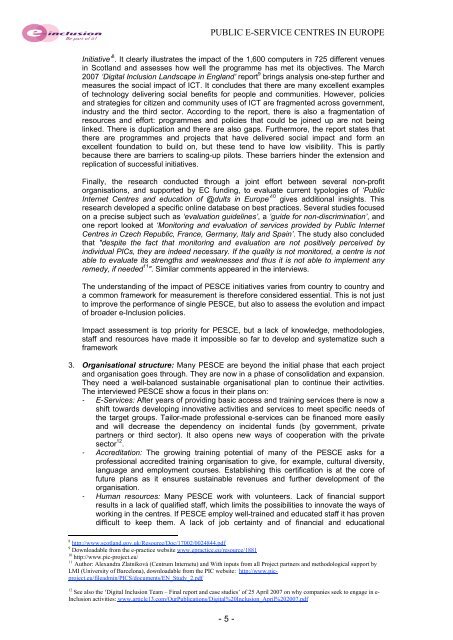Comparative Study of Public e-Service Centres in - ePractice.eu
Comparative Study of Public e-Service Centres in - ePractice.eu
Comparative Study of Public e-Service Centres in - ePractice.eu
Create successful ePaper yourself
Turn your PDF publications into a flip-book with our unique Google optimized e-Paper software.
PUBLIC E-SERVICE CENTRES IN EUROPE<br />
Initiative’ 8 . It clearly illustrates the impact <strong>of</strong> the 1,600 computers <strong>in</strong> 725 different venues<br />
<strong>in</strong> Scotland and assesses how well the programme has met its objectives. The March<br />
2007 ‘Digital Inclusion Landscape <strong>in</strong> England’ report 9 br<strong>in</strong>gs analysis one-step further and<br />
measures the social impact <strong>of</strong> ICT. It concludes that there are many excellent examples<br />
<strong>of</strong> technology deliver<strong>in</strong>g social benefits for people and communities. However, policies<br />
and strategies for citizen and community uses <strong>of</strong> ICT are fragmented across government,<br />
<strong>in</strong>dustry and the third sector. Accord<strong>in</strong>g to the report, there is also a fragmentation <strong>of</strong><br />
resources and effort: programmes and policies that could be jo<strong>in</strong>ed up are not be<strong>in</strong>g<br />
l<strong>in</strong>ked. There is duplication and there are also gaps. Furthermore, the report states that<br />
there are programmes and projects that have delivered social impact and form an<br />
excellent foundation to build on, but these tend to have low visibility. This is partly<br />
because there are barriers to scal<strong>in</strong>g-up pilots. These barriers h<strong>in</strong>der the extension and<br />
replication <strong>of</strong> successful <strong>in</strong>itiatives.<br />
F<strong>in</strong>ally, the research conducted through a jo<strong>in</strong>t effort between several non-pr<strong>of</strong>it<br />
organisations, and supported by EC fund<strong>in</strong>g, to evaluate current typologies <strong>of</strong> ‘<strong>Public</strong><br />
Internet <strong>Centres</strong> and education <strong>of</strong> @dults <strong>in</strong> Europe’ 10 gives additional <strong>in</strong>sights. This<br />
research developed a specific onl<strong>in</strong>e database on best practices. Several studies focused<br />
on a precise subject such as ‘evaluation guidel<strong>in</strong>es’, a ‘guide for non-discrim<strong>in</strong>ation’, and<br />
one report looked at ‘Monitor<strong>in</strong>g and evaluation <strong>of</strong> services provided by <strong>Public</strong> Internet<br />
<strong>Centres</strong> <strong>in</strong> Czech Republic, France, Germany, Italy and Spa<strong>in</strong>’. The study also concluded<br />
that "despite the fact that monitor<strong>in</strong>g and evaluation are not positively perceived by<br />
<strong>in</strong>dividual PICs, they are <strong>in</strong>deed necessary. If the quality is not monitored, a centre is not<br />
able to evaluate its strengths and weaknesses and thus it is not able to implement any<br />
remedy, if needed 11 ". Similar comments appeared <strong>in</strong> the <strong>in</strong>terviews.<br />
The understand<strong>in</strong>g <strong>of</strong> the impact <strong>of</strong> PESCE <strong>in</strong>itiatives varies from country to country and<br />
a common framework for measurement is therefore considered essential. This is not just<br />
to improve the performance <strong>of</strong> s<strong>in</strong>gle PESCE, but also to assess the evolution and impact<br />
<strong>of</strong> broader e-Inclusion policies.<br />
Impact assessment is top priority for PESCE, but a lack <strong>of</strong> knowledge, methodologies,<br />
staff and resources have made it impossible so far to develop and systematize such a<br />
framework<br />
3. Organisational structure: Many PESCE are beyond the <strong>in</strong>itial phase that each project<br />
and organisation goes through. They are now <strong>in</strong> a phase <strong>of</strong> consolidation and expansion.<br />
They need a well-balanced susta<strong>in</strong>able organisational plan to cont<strong>in</strong>ue their activities.<br />
The <strong>in</strong>terviewed PESCE show a focus <strong>in</strong> their plans on:<br />
- E-<strong>Service</strong>s: After years <strong>of</strong> provid<strong>in</strong>g basic access and tra<strong>in</strong><strong>in</strong>g services there is now a<br />
shift towards develop<strong>in</strong>g <strong>in</strong>novative activities and services to meet specific needs <strong>of</strong><br />
the target groups. Tailor-made pr<strong>of</strong>essional e-services can be f<strong>in</strong>anced more easily<br />
and will decrease the dependency on <strong>in</strong>cidental funds (by government, private<br />
partners or third sector). It also opens new ways <strong>of</strong> cooperation with the private<br />
sector 12 .<br />
- Accreditation: The grow<strong>in</strong>g tra<strong>in</strong><strong>in</strong>g potential <strong>of</strong> many <strong>of</strong> the PESCE asks for a<br />
pr<strong>of</strong>essional accredited tra<strong>in</strong><strong>in</strong>g organisation to give, for example, cultural diversity,<br />
language and employment courses. Establish<strong>in</strong>g this certification is at the core <strong>of</strong><br />
future plans as it ensures susta<strong>in</strong>able revenues and further development <strong>of</strong> the<br />
organisation.<br />
- Human resources: Many PESCE work with volunteers. Lack <strong>of</strong> f<strong>in</strong>ancial support<br />
results <strong>in</strong> a lack <strong>of</strong> qualified staff, which limits the possibilities to <strong>in</strong>novate the ways <strong>of</strong><br />
work<strong>in</strong>g <strong>in</strong> the centres. If PESCE employ well-tra<strong>in</strong>ed and educated staff it has proven<br />
difficult to keep them. A lack <strong>of</strong> job certa<strong>in</strong>ty and <strong>of</strong> f<strong>in</strong>ancial and educational<br />
8<br />
http://www.scotland.gov.uk/Resource/Doc/17002/0024844.pdf<br />
9<br />
Downloadable from the e-practice website www.epractice.<strong>eu</strong>/resource/1881<br />
10<br />
http://www.pic-project.<strong>eu</strong>/<br />
11<br />
Author: Alexandra Zlatníková (Centrum Internetu) and With <strong>in</strong>puts from all Project partners and methodological support by<br />
LMI (University <strong>of</strong> Barcelona), downloadable from the PIC website: http://www.picproject.<strong>eu</strong>/fileadm<strong>in</strong>/PICS/documents/EN_<strong>Study</strong>_2.pdf<br />
12 See also the ‘Digital Inclusion Team – F<strong>in</strong>al report and case studies’ <strong>of</strong> 25 April 2007 on why companies seek to engage <strong>in</strong> e-<br />
Inclusion activities: www.article13.com/Our<strong>Public</strong>ations/Digital%20Inclusion_April%202007.pdf<br />
- 5 -
















